Home / The Pi Molecular Orbitals of Benzene
Aromaticity
The Pi Molecular Orbitals of Benzene
Last updated: May 7th, 2025 |
The Pi Molecular Orbitals of Benzene
Today, let’s go through how to draw out the molecular orbitals of benzene. We’ll compare them with the molecular orbitals for (linear) hexatriene. The big takeaway is that from contrasting the molecular orbitals of these two 6-electron pi systems, we will unlock the deep, mysterious riddle of why benzene is so unusually stable.
Quick spoiler. Here’s of what the molecular orbitals of benzene look like.

The rest of this post will describe how we came up with this drawing and what it means.
Table of Contents
- Quickie Review: How To Draw Pi Molecular Orbitals For A Given Pi System
- Building The Pi Molecular Orbital Diagram For Benzene: Hexatriene and Benzene Each Have Six Pi Molecular Orbitals
- The Lowest-Energy Molecular Orbitals Of Hexatriene And Benzene Have Zero Nodes
- The “Penthouse” Of The M.O. Diagram (Highest Energy Level) Has The Maximum Number Of Nodes
- Benzene Has Nodal Planes. The Maximum Energy Level Has 3 Nodal Planes
- Where Do We Place The Nodes In The Intermediate Energy Levels Of Benzene?
- The Benzene Molecular Orbital Diagram: Putting It All Together
- Filling Out The Rest of The Picture For Benzene
- Why Is Benzene More Stable Than Hexatriene?
- Notes
- Quiz Yourself!
- (Advanced) References and Further Reading
1. Quickie Review: How To Draw Pi Molecular Orbitals For A Given Pi System
Previously we’ve looked at the molecular orbitals of the allyl system, and of butadiene. We learned some key lessons for drawing out the molecular orbitals of (linear) pi systems that I will quickly rehash here.
Think of drawing out the pi orbitals as a bit like constructing an apartment building, albeit with some strange municipal building codes and quirky tenant behaviour.
- The number of pi molecular orbitals in the pi-system equals the number of contributing atomic p orbitals. For butadiene (n=4) we saw that the energy levels of the pi system stacked like a four-story apartment building. Both hexatriene and benzene have six contributing p-orbitals (n = 6), so we should expect six pi orbitals for each.
- The number of nodes increases with each successive energy level. A “node” is where there is a change in phase between adjacent p-orbitals (i.e. where they can’t constructively overlap). The lowest energy level (the “ground floor”, if you will) has all the p-orbitals aligned the same way, and therefore has zero nodes between the p orbitals (not counting the node inherent to the p-orbitals that lies in the plane of the molecule). This provides the greatest possible delocalization of the electrons, and hence is the lowest in energy. Here’s what the “ground floor” looks like for butadiene:

The highest energy level (the “penthouse” of our building) has (n–1) nodes. We saw that for butadiene (n=4) the highest energy level has three nodes between the orbitals (marked here with red lines).

The Ground Floor and the Penthouse are the easiest levels to draw, because they follow from simple rules: align all phases, or alternate all phases.
The tricky part is drawing the orbitals in the intermediate energy levels, due to the quantum-mechanical municipal bylaw that I call the Balanced Node Rule. Because (math), nodes can’t just be placed anywhere; they’re always arranged symmetrically with the respect to the centre of the orbital.
- A single node must cut through the centre of the molecular orbital.
- Two nodes must be placed an equal distance from the centre (i.e. such that they are balanced with respect to the centre)
- Each successive energy level adds an extra node. Note that an orbital with an odd number of nodes will always have one node in the centre.
The final task in drawing the molecular orbitals is to fill up our building with tenants (electrons) using the familiar Aufbau principle: starting with the ground floor, each unit (orbital) fills up one electron at a time, to a maximum occupancy of two. [Note 1]
Now let’s apply this framework to hexatriene and benzene.
2. Building The Pi Molecular Orbital Diagram For Benzene: Hexatriene and Benzene Each Have Six Pi Molecular Orbitals
Hopefully straightforward! Six p orbitals in the pi systems of benzene and hexatriene will produce six pi molecular orbitals.
The levels in hexatriene stack like a six-story building. Benzene has a different arrangement, for reasons we’ll quickly see below.
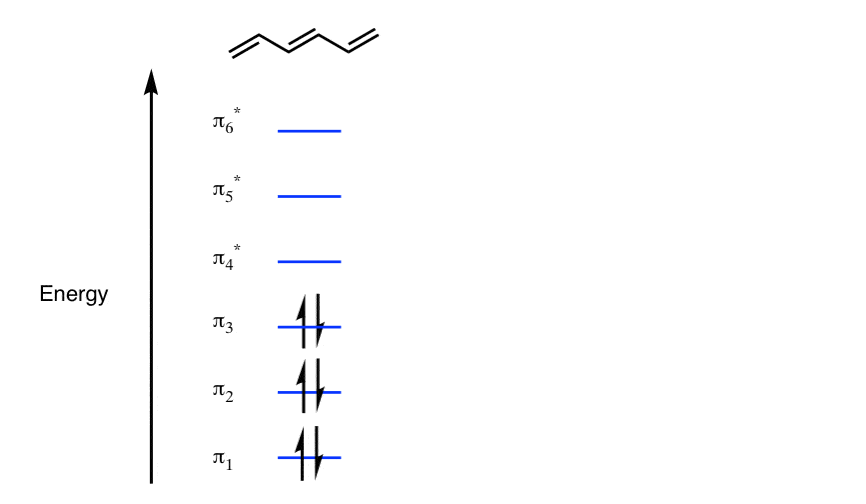
Note that the bottom three orbitals are all bonding orbitals and the top three orbitals are antibonding. Only the bottom three “floors” are occupied in neutral hexatriene. (If every floor in this building were completely filled with tenants (electrons) the building would quickly self-destruct. Talk about a messed-up building)
3. The Lowest-Energy Molecular Orbitals Of Hexatriene And Benzene Have Zero Nodes
Following the pattern described above for butadiene, we draw the “ground floor” first, with the phases of all p-orbitals aligned the same way. It doesn’t matter if you draw the “shaded” or “white” lobes up or down, so long as they are all drawn the same way.
Here’s what they look like for hexatriene and benzene:
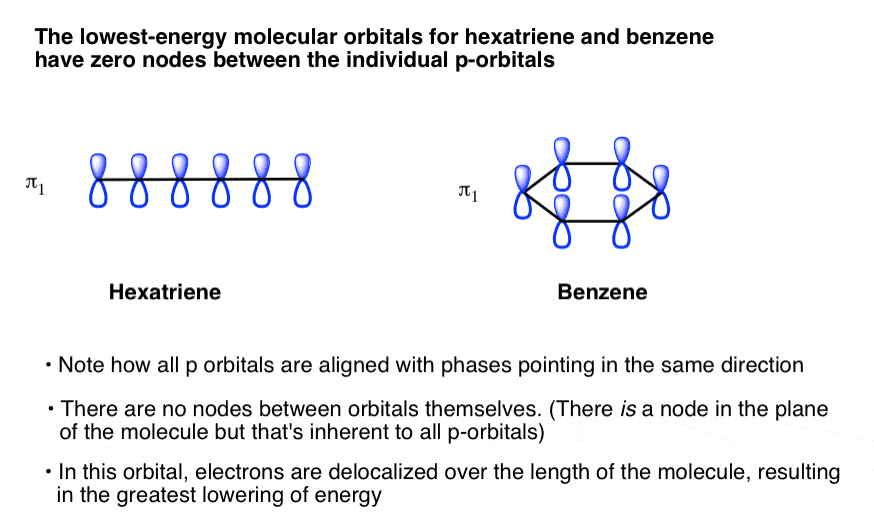
4. The “Penthouse” Of The M.O. Diagram (Highest Energy Level) Has The Maximum Number Of Nodes
The Highest Energy molecular orbitals have p orbitals with completely alternating phases.
Like the ground floor, the highest-energy molecular orbital (the “penthouse”) of a pi system is also straightforward to draw.
Draw all the p orbitals with alternating phases. No two adjacent p orbitals should have lobes with the same phase.
For linear systems, we’ve seen that this gives the highest energy level (n–1) nodes. For hexatriene (n=6) that means that the highest energy level will have 5 nodes.
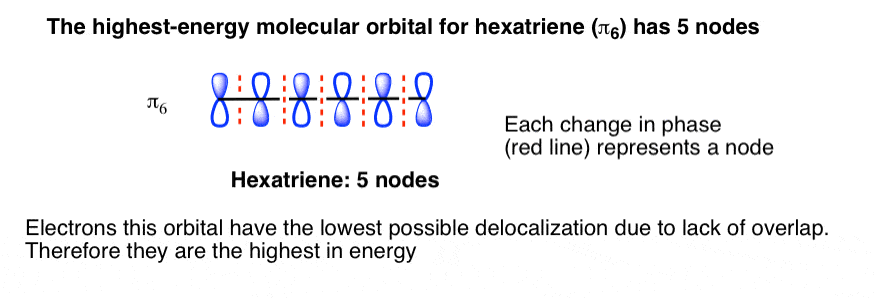
What about benzene? This is where things get interesting.
5. Benzene Has Nodal Planes. The Maximum Energy Level Has 3 Nodal Planes
In the case of cyclic systems, the (n–1) rule fails. Drawing a molecular orbital of benzene with 5 nodes is like solving 5 faces of a Rubik’s cube: impossible. A meelion dollars if you can prove me wrong: try it! [Note 2]
We can, however, easily draw an orbital where all the phases alternate. In this case, though, we can count six places where the phases change. Instead of looking at these as individual nodes, it’s perhaps more helpful to think of these as three nodal planes, which cut through the molecule at various points.
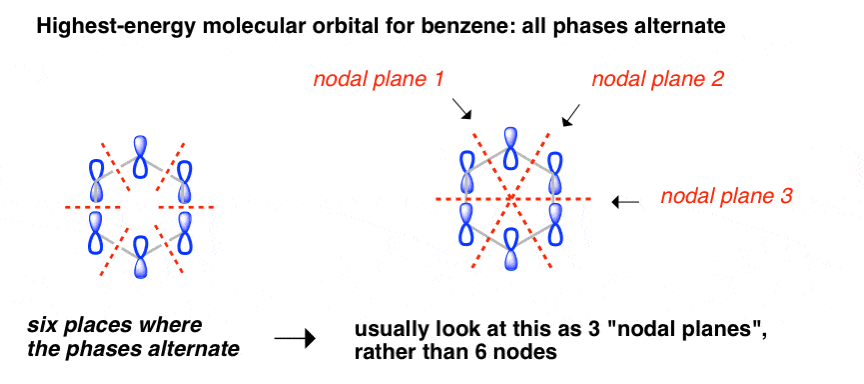
This orbital has zero overlap between adjacent p orbitals and therefore electrons in this orbital have the minimum possible delocalization. They are therefore the highest energy.
6. Where Do We Place The Nodes In The Intermediate Energy Levels Of Benzene?
As we said above, the tricky thing in building pi molecular orbitals is knowing where to put the nodes in the intermediate levels.
For hexatriene, the second floor (one node) is fairly straightfoward: we put the node in the centre, like this:

It’s impossible to draw a cyclic pi system with one node, but we can draw a system with one nodal plane. Here, for instance, we’ve drawn a nodal plane that cuts through two of the single bonds:

But wait! There’s actually a second way to do it. We can also draw a nodal plane through the atoms, like this.

These two molecular orbitals (π2 and π3 ) have the same number of nodal planes, and therefore have the same energy. The way we usually describe this in chemistry is by saying the orbitals are degenerate.
This is really the key difference in the molecular orbital picture of a cyclic system versus an acyclic system: two units can co-exist on the same floor. For benzene, that results in a lowering of energy.
7. Filling Out The Rest of The Picture For Benzene
Here’s the third, fourth, and fifth “floors” for the hexatriene pi system, which have two, three, and four nodes, respectively.
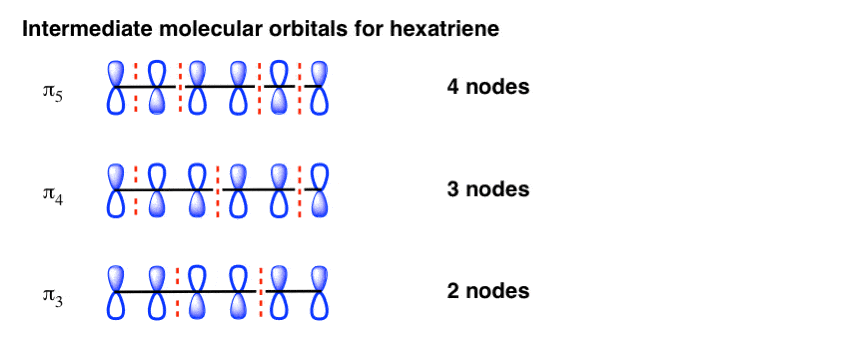
For benzene, the next level up has two nodal planes. Again, there’s two ways to do it: cut through the bonds, or cut through the atoms. Again, these are of the same energy.

8. The Benzene Molecular Orbital Diagram: Putting It All Together
The final step is to arrange all the pi orbitals together (by “floors”) and then to fill each level with electrons (“tenants”).
Here’s the complete molecular orbital picture for hexatriene:
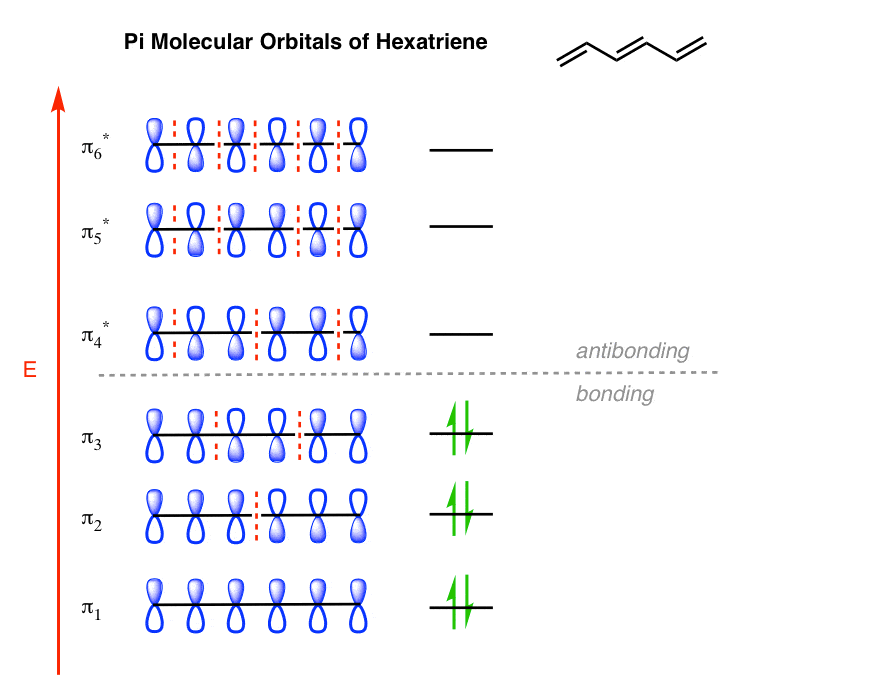
The complete molecular orbital picture for benzene was drawn at the top of the post, but here it is again for your non-scrolling pleasure:
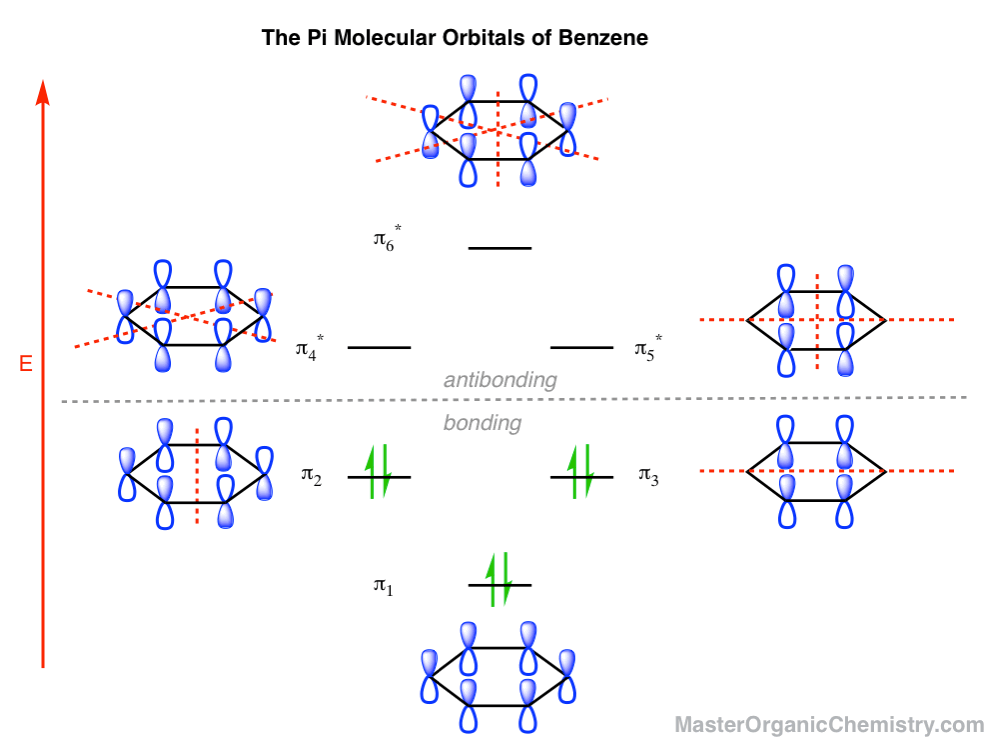
See the key difference? Describing it as “a more efficient stacking of energy levels” isn’t far off.

9. Why Is Benzene More Stable Than Hexatriene?
A cyclic pi system allows for two ways to place a single nodal plane: through-bond, or through-atom. In benzene, this means that the second and third “floors” each have two units with the same energy – they are “degenerate”.
To follow our somewhat crude analogy, both buildings have six “tenants”, but in benzene, those tenants aren’t as high off the ground – and thus have less potential energy.
In chemistry terms, the highest occupied molecular orbitals (HOMO) of benzene are lower in energy than the highest occupied molecular orbital (HOMO) of hexatriene. And for our purposes, that lower energy of the pi-electrons translates into lower reactivity. [Note 3]
It’s an imperfect analogy, but for our purposes, it will do.
In the next post, let’s see if we can examine the molecular orbitals for anti-aromatic cyclobutadiene and similarly gain insights into its unusual instability.
Thanks to Tom Struble for his contributions to this article.
Notes
Related Articles
- The Pi Molecular Orbitals of Cyclobutadiene
- Frost Circles
- Aromatic, Non-Aromatic, or Antiaromatic? Some Practice Problems
- Pi Molecular Orbitals of Butadiene
- Molecular Orbitals of The Allyl Cation, Allyl Radical, and Allyl Anion
- Conjugation And Resonance In Organic Chemistry
- Aromaticity Practice Quizzes (MOC Membership)
Note 1. Before the invention of the elevator, offices on the ground floors of buildings were the most coveted. The Aufbau principle harkens back to those days when the “penthouse” was the least desirable floor of the building because it involved trudging up the most stairs.
Note 2. Start with the π6 molecular orbital of benzene, which has six sites where the phases change. Flipping the phases of any one of those p orbitals gives you a molecular orbital with 4 nodes (two nodal planes). Similarly it can be shown that the molecular orbitals of benzene can only have an even number of nodes.
Note 3. Specifically, the lower the energy of the HOMO, the lower its reactivity as a nucleophile.
Quiz Yourself!

Become a MOC member to see the clickable quiz with answers on the back.

Become a MOC member to see the clickable quiz with answers on the back.

Become a MOC member to see the clickable quiz with answers on the back.

Become a MOC member to see the clickable quiz with answers on the back.
(Advanced) References and Further Reading
- Quantentheoretische Beiträge zum Benzolproblem
Die Elektronenkonfiguration des Benzols und verwandter Verbindungen
Erich Hückel
Zeitschrift für Physik 1931, 70, 204–286
DOI: 10.1007/BF01339530
Erich Hückel achieved recognition by elaborating, together with Peter Debye, the theory of strong electrolytes in 1923 and later by applying a simplified version of quantum theory to p-electrons in conjugated molecules, which became known as Hückel molecular orbital (HMO) theory. Although he never explicitly formulated a “4n + 2 rule”, this was obvious from his work. Hückel showed that monocyclic systems with continuous conjugation having 6, 10, 14, etc. p-electrons benefited from extra stabilization and were aromatic. But it is more accurate to refer to the “Hückel 4n + 2 p-electron rule,” rather than to “Hückel’s rule.” - A Mnemonic Device for Molecular Orbital Energies
Arthur A. Frost and Boris Musulin
J. Chem. Phys. 1953, 21, 572
DOI: 10.1063/1.1698970
The origin of the “Frost Circle” mnemonic device for determining the MO’s of electrocyclic systems. - Crocker, Not Armit and Robinson, Begat the Six Aromatic Electrons
Alexandru T. Balaban, Paul v. R. Schleyer, and Henry S. Rzepa
Chemical Reviews 2005, 105 (10), 3436-3447
DOI: 1021/cr0300946
A review by some very famous chemists on the history of aromaticity theory gives evidence that the origin of benzene’s 6 p electrons has been consistently mis-cited in the literature! A nice read for those interested in the history of chemistry.
00 General Chemistry Review
01 Bonding, Structure, and Resonance
- How Do We Know Methane (CH4) Is Tetrahedral?
- Hybrid Orbitals and Hybridization
- How To Determine Hybridization: A Shortcut
- Orbital Hybridization And Bond Strengths
- Sigma bonds come in six varieties: Pi bonds come in one
- A Key Skill: How to Calculate Formal Charge
- The Four Intermolecular Forces and How They Affect Boiling Points
- 3 Trends That Affect Boiling Points
- How To Use Electronegativity To Determine Electron Density (and why NOT to trust formal charge)
- Introduction to Resonance
- How To Use Curved Arrows To Interchange Resonance Forms
- Evaluating Resonance Forms (1) - The Rule of Least Charges
- How To Find The Best Resonance Structure By Applying Electronegativity
- Evaluating Resonance Structures With Negative Charges
- Evaluating Resonance Structures With Positive Charge
- Exploring Resonance: Pi-Donation
- Exploring Resonance: Pi-acceptors
- In Summary: Evaluating Resonance Structures
- Drawing Resonance Structures: 3 Common Mistakes To Avoid
- How to apply electronegativity and resonance to understand reactivity
- Bond Hybridization Practice
- Structure and Bonding Practice Quizzes
- Resonance Structures Practice
02 Acid Base Reactions
- Introduction to Acid-Base Reactions
- Acid Base Reactions In Organic Chemistry
- The Stronger The Acid, The Weaker The Conjugate Base
- Walkthrough of Acid-Base Reactions (3) - Acidity Trends
- Five Key Factors That Influence Acidity
- Acid-Base Reactions: Introducing Ka and pKa
- How to Use a pKa Table
- The pKa Table Is Your Friend
- A Handy Rule of Thumb for Acid-Base Reactions
- Acid Base Reactions Are Fast
- pKa Values Span 60 Orders Of Magnitude
- How Protonation and Deprotonation Affect Reactivity
- Acid Base Practice Problems
03 Alkanes and Nomenclature
- Meet the (Most Important) Functional Groups
- Condensed Formulas: Deciphering What the Brackets Mean
- Hidden Hydrogens, Hidden Lone Pairs, Hidden Counterions
- Don't Be Futyl, Learn The Butyls
- Primary, Secondary, Tertiary, Quaternary In Organic Chemistry
- Branching, and Its Affect On Melting and Boiling Points
- The Many, Many Ways of Drawing Butane
- Wedge And Dash Convention For Tetrahedral Carbon
- Common Mistakes in Organic Chemistry: Pentavalent Carbon
- Table of Functional Group Priorities for Nomenclature
- Summary Sheet - Alkane Nomenclature
- Organic Chemistry IUPAC Nomenclature Demystified With A Simple Puzzle Piece Approach
- Boiling Point Quizzes
- Organic Chemistry Nomenclature Quizzes
04 Conformations and Cycloalkanes
- Staggered vs Eclipsed Conformations of Ethane
- Conformational Isomers of Propane
- Newman Projection of Butane (and Gauche Conformation)
- Introduction to Cycloalkanes
- Geometric Isomers In Small Rings: Cis And Trans Cycloalkanes
- Calculation of Ring Strain In Cycloalkanes
- Cycloalkanes - Ring Strain In Cyclopropane And Cyclobutane
- Cyclohexane Conformations
- Cyclohexane Chair Conformation: An Aerial Tour
- How To Draw The Cyclohexane Chair Conformation
- The Cyclohexane Chair Flip
- The Cyclohexane Chair Flip - Energy Diagram
- Substituted Cyclohexanes - Axial vs Equatorial
- Ranking The Bulkiness Of Substituents On Cyclohexanes: "A-Values"
- Cyclohexane Chair Conformation Stability: Which One Is Lower Energy?
- Fused Rings - Cis-Decalin and Trans-Decalin
- Naming Bicyclic Compounds - Fused, Bridged, and Spiro
- Bredt's Rule (And Summary of Cycloalkanes)
- Newman Projection Practice
- Cycloalkanes Practice Problems
05 A Primer On Organic Reactions
- The Most Important Question To Ask When Learning a New Reaction
- Curved Arrows (for reactions)
- Nucleophiles and Electrophiles
- The Three Classes of Nucleophiles
- Nucleophilicity vs. Basicity
- What Makes A Good Nucleophile?
- What Makes A Good Leaving Group?
- 3 Factors That Stabilize Carbocations
- Equilibrium and Energy Relationships
- 7 Factors that stabilize negative charge in organic chemistry
- 7 Factors That Stabilize Positive Charge in Organic Chemistry
- What's a Transition State?
- Hammond's Postulate
- Learning Organic Chemistry Reactions: A Checklist (PDF)
- Introduction to Oxidative Cleavage Reactions
06 Free Radical Reactions
- Bond Dissociation Energies = Homolytic Cleavage
- Free Radical Reactions
- 3 Factors That Stabilize Free Radicals
- What Factors Destabilize Free Radicals?
- Bond Strengths And Radical Stability
- Free Radical Initiation: Why Is "Light" Or "Heat" Required?
- Initiation, Propagation, Termination
- Monochlorination Products Of Propane, Pentane, And Other Alkanes
- Selectivity In Free Radical Reactions
- Selectivity in Free Radical Reactions: Bromination vs. Chlorination
- Halogenation At Tiffany's
- Allylic Bromination
- Bonus Topic: Allylic Rearrangements
- In Summary: Free Radicals
- Synthesis (2) - Reactions of Alkanes
- Free Radicals Practice Quizzes
07 Stereochemistry and Chirality
- Types of Isomers: Constitutional Isomers, Stereoisomers, Enantiomers, and Diastereomers
- How To Draw The Enantiomer Of A Chiral Molecule
- How To Draw A Bond Rotation
- Introduction to Assigning (R) and (S): The Cahn-Ingold-Prelog Rules
- Assigning Cahn-Ingold-Prelog (CIP) Priorities (2) - The Method of Dots
- Enantiomers vs Diastereomers vs The Same? Two Methods For Solving Problems
- Assigning R/S To Newman Projections (And Converting Newman To Line Diagrams)
- How To Determine R and S Configurations On A Fischer Projection
- The Meso Trap
- Optical Rotation, Optical Activity, and Specific Rotation
- Optical Purity and Enantiomeric Excess
- What's a Racemic Mixture?
- Chiral Allenes And Chiral Axes
- Stereochemistry Practice Problems and Quizzes
08 Substitution Reactions
- Nucleophilic Substitution Reactions - Introduction
- Two Types of Nucleophilic Substitution Reactions
- The SN2 Mechanism
- Why the SN2 Reaction Is Powerful
- The SN1 Mechanism
- The Conjugate Acid Is A Better Leaving Group
- Comparing the SN1 and SN2 Reactions
- Polar Protic? Polar Aprotic? Nonpolar? All About Solvents
- Steric Hindrance is Like a Fat Goalie
- Common Blind Spot: Intramolecular Reactions
- Substitution Practice - SN1
- Substitution Practice - SN2
09 Elimination Reactions
- Elimination Reactions (1): Introduction And The Key Pattern
- Elimination Reactions (2): The Zaitsev Rule
- Elimination Reactions Are Favored By Heat
- Two Elimination Reaction Patterns
- The E1 Reaction
- The E2 Mechanism
- E1 vs E2: Comparing the E1 and E2 Reactions
- Antiperiplanar Relationships: The E2 Reaction and Cyclohexane Rings
- Bulky Bases in Elimination Reactions
- Comparing the E1 vs SN1 Reactions
- Elimination (E1) Reactions With Rearrangements
- E1cB - Elimination (Unimolecular) Conjugate Base
- Elimination (E1) Practice Problems And Solutions
- Elimination (E2) Practice Problems and Solutions
10 Rearrangements
11 SN1/SN2/E1/E2 Decision
- Identifying Where Substitution and Elimination Reactions Happen
- Deciding SN1/SN2/E1/E2 (1) - The Substrate
- Deciding SN1/SN2/E1/E2 (2) - The Nucleophile/Base
- SN1 vs E1 and SN2 vs E2 : The Temperature
- Deciding SN1/SN2/E1/E2 - The Solvent
- Wrapup: The Key Factors For Determining SN1/SN2/E1/E2
- Alkyl Halide Reaction Map And Summary
- SN1 SN2 E1 E2 Practice Problems
12 Alkene Reactions
- E and Z Notation For Alkenes (+ Cis/Trans)
- Alkene Stability
- Alkene Addition Reactions: "Regioselectivity" and "Stereoselectivity" (Syn/Anti)
- Stereoselective and Stereospecific Reactions
- Hydrohalogenation of Alkenes and Markovnikov's Rule
- Hydration of Alkenes With Aqueous Acid
- Rearrangements in Alkene Addition Reactions
- Halogenation of Alkenes and Halohydrin Formation
- Oxymercuration Demercuration of Alkenes
- Hydroboration Oxidation of Alkenes
- m-CPBA (meta-chloroperoxybenzoic acid)
- OsO4 (Osmium Tetroxide) for Dihydroxylation of Alkenes
- Palladium on Carbon (Pd/C) for Catalytic Hydrogenation of Alkenes
- Cyclopropanation of Alkenes
- A Fourth Alkene Addition Pattern - Free Radical Addition
- Alkene Reactions: Ozonolysis
- Summary: Three Key Families Of Alkene Reaction Mechanisms
- Synthesis (4) - Alkene Reaction Map, Including Alkyl Halide Reactions
- Alkene Reactions Practice Problems
13 Alkyne Reactions
- Acetylides from Alkynes, And Substitution Reactions of Acetylides
- Partial Reduction of Alkynes With Lindlar's Catalyst
- Partial Reduction of Alkynes With Na/NH3 To Obtain Trans Alkenes
- Alkyne Hydroboration With "R2BH"
- Hydration and Oxymercuration of Alkynes
- Hydrohalogenation of Alkynes
- Alkyne Halogenation: Bromination and Chlorination of Alkynes
- Alkyne Reactions - The "Concerted" Pathway
- Alkenes To Alkynes Via Halogenation And Elimination Reactions
- Alkynes Are A Blank Canvas
- Synthesis (5) - Reactions of Alkynes
- Alkyne Reactions Practice Problems With Answers
14 Alcohols, Epoxides and Ethers
- Alcohols - Nomenclature and Properties
- Alcohols Can Act As Acids Or Bases (And Why It Matters)
- Alcohols - Acidity and Basicity
- The Williamson Ether Synthesis
- Ethers From Alkenes, Tertiary Alkyl Halides and Alkoxymercuration
- Alcohols To Ethers via Acid Catalysis
- Cleavage Of Ethers With Acid
- Epoxides - The Outlier Of The Ether Family
- Opening of Epoxides With Acid
- Epoxide Ring Opening With Base
- Making Alkyl Halides From Alcohols
- Tosylates And Mesylates
- PBr3 and SOCl2
- Elimination Reactions of Alcohols
- Elimination of Alcohols To Alkenes With POCl3
- Alcohol Oxidation: "Strong" and "Weak" Oxidants
- Demystifying The Mechanisms of Alcohol Oxidations
- Protecting Groups For Alcohols
- Thiols And Thioethers
- Calculating the oxidation state of a carbon
- Oxidation and Reduction in Organic Chemistry
- Oxidation Ladders
- SOCl2 Mechanism For Alcohols To Alkyl Halides: SN2 versus SNi
- Alcohol Reactions Roadmap (PDF)
- Alcohol Reaction Practice Problems
- Epoxide Reaction Quizzes
- Oxidation and Reduction Practice Quizzes
15 Organometallics
- What's An Organometallic?
- Formation of Grignard and Organolithium Reagents
- Organometallics Are Strong Bases
- Reactions of Grignard Reagents
- Protecting Groups In Grignard Reactions
- Synthesis Problems Involving Grignard Reagents
- Grignard Reactions And Synthesis (2)
- Organocuprates (Gilman Reagents): How They're Made
- Gilman Reagents (Organocuprates): What They're Used For
- The Heck, Suzuki, and Olefin Metathesis Reactions (And Why They Don't Belong In Most Introductory Organic Chemistry Courses)
- Reaction Map: Reactions of Organometallics
- Grignard Practice Problems
16 Spectroscopy
- Degrees of Unsaturation (or IHD, Index of Hydrogen Deficiency)
- Conjugation And Color (+ How Bleach Works)
- Introduction To UV-Vis Spectroscopy
- UV-Vis Spectroscopy: Absorbance of Carbonyls
- UV-Vis Spectroscopy: Practice Questions
- Bond Vibrations, Infrared Spectroscopy, and the "Ball and Spring" Model
- Infrared Spectroscopy: A Quick Primer On Interpreting Spectra
- IR Spectroscopy: 4 Practice Problems
- 1H NMR: How Many Signals?
- Homotopic, Enantiotopic, Diastereotopic
- Diastereotopic Protons in 1H NMR Spectroscopy: Examples
- 13-C NMR - How Many Signals
- Liquid Gold: Pheromones In Doe Urine
- Natural Product Isolation (1) - Extraction
- Natural Product Isolation (2) - Purification Techniques, An Overview
- Structure Determination Case Study: Deer Tarsal Gland Pheromone
17 Dienes and MO Theory
- What To Expect In Organic Chemistry 2
- Are these molecules conjugated?
- Conjugation And Resonance In Organic Chemistry
- Bonding And Antibonding Pi Orbitals
- Molecular Orbitals of The Allyl Cation, Allyl Radical, and Allyl Anion
- Pi Molecular Orbitals of Butadiene
- Reactions of Dienes: 1,2 and 1,4 Addition
- Thermodynamic and Kinetic Products
- More On 1,2 and 1,4 Additions To Dienes
- s-cis and s-trans
- The Diels-Alder Reaction
- Cyclic Dienes and Dienophiles in the Diels-Alder Reaction
- Stereochemistry of the Diels-Alder Reaction
- Exo vs Endo Products In The Diels Alder: How To Tell Them Apart
- HOMO and LUMO In the Diels Alder Reaction
- Why Are Endo vs Exo Products Favored in the Diels-Alder Reaction?
- Diels-Alder Reaction: Kinetic and Thermodynamic Control
- The Retro Diels-Alder Reaction
- The Intramolecular Diels Alder Reaction
- Regiochemistry In The Diels-Alder Reaction
- The Cope and Claisen Rearrangements
- Electrocyclic Reactions
- Electrocyclic Ring Opening And Closure (2) - Six (or Eight) Pi Electrons
- Diels Alder Practice Problems
- Molecular Orbital Theory Practice
18 Aromaticity
- Introduction To Aromaticity
- Rules For Aromaticity
- Huckel's Rule: What Does 4n+2 Mean?
- Aromatic, Non-Aromatic, or Antiaromatic? Some Practice Problems
- Antiaromatic Compounds and Antiaromaticity
- The Pi Molecular Orbitals of Benzene
- The Pi Molecular Orbitals of Cyclobutadiene
- Frost Circles
- Aromaticity Practice Quizzes
19 Reactions of Aromatic Molecules
- Electrophilic Aromatic Substitution: Introduction
- Activating and Deactivating Groups In Electrophilic Aromatic Substitution
- Electrophilic Aromatic Substitution - The Mechanism
- Ortho-, Para- and Meta- Directors in Electrophilic Aromatic Substitution
- Understanding Ortho, Para, and Meta Directors
- Why are halogens ortho- para- directors?
- Disubstituted Benzenes: The Strongest Electron-Donor "Wins"
- Electrophilic Aromatic Substitutions (1) - Halogenation of Benzene
- Electrophilic Aromatic Substitutions (2) - Nitration and Sulfonation
- EAS Reactions (3) - Friedel-Crafts Acylation and Friedel-Crafts Alkylation
- Intramolecular Friedel-Crafts Reactions
- Nucleophilic Aromatic Substitution (NAS)
- Nucleophilic Aromatic Substitution (2) - The Benzyne Mechanism
- Reactions on the "Benzylic" Carbon: Bromination And Oxidation
- The Wolff-Kishner, Clemmensen, And Other Carbonyl Reductions
- More Reactions on the Aromatic Sidechain: Reduction of Nitro Groups and the Baeyer Villiger
- Aromatic Synthesis (1) - "Order Of Operations"
- Synthesis of Benzene Derivatives (2) - Polarity Reversal
- Aromatic Synthesis (3) - Sulfonyl Blocking Groups
- Birch Reduction
- Synthesis (7): Reaction Map of Benzene and Related Aromatic Compounds
- Aromatic Reactions and Synthesis Practice
- Electrophilic Aromatic Substitution Practice Problems
20 Aldehydes and Ketones
- What's The Alpha Carbon In Carbonyl Compounds?
- Nucleophilic Addition To Carbonyls
- Aldehydes and Ketones: 14 Reactions With The Same Mechanism
- Sodium Borohydride (NaBH4) Reduction of Aldehydes and Ketones
- Grignard Reagents For Addition To Aldehydes and Ketones
- Wittig Reaction
- Hydrates, Hemiacetals, and Acetals
- Imines - Properties, Formation, Reactions, and Mechanisms
- All About Enamines
- Breaking Down Carbonyl Reaction Mechanisms: Reactions of Anionic Nucleophiles (Part 2)
- Aldehydes Ketones Reaction Practice
21 Carboxylic Acid Derivatives
- Nucleophilic Acyl Substitution (With Negatively Charged Nucleophiles)
- Addition-Elimination Mechanisms With Neutral Nucleophiles (Including Acid Catalysis)
- Basic Hydrolysis of Esters - Saponification
- Transesterification
- Proton Transfer
- Fischer Esterification - Carboxylic Acid to Ester Under Acidic Conditions
- Lithium Aluminum Hydride (LiAlH4) For Reduction of Carboxylic Acid Derivatives
- LiAlH[Ot-Bu]3 For The Reduction of Acid Halides To Aldehydes
- Di-isobutyl Aluminum Hydride (DIBAL) For The Partial Reduction of Esters and Nitriles
- Amide Hydrolysis
- Thionyl Chloride (SOCl2) And Conversion of Carboxylic Acids to Acid Halides
- Diazomethane (CH2N2)
- Carbonyl Chemistry: Learn Six Mechanisms For the Price Of One
- Making Music With Mechanisms (PADPED)
- Carboxylic Acid Derivatives Practice Questions
22 Enols and Enolates
- Keto-Enol Tautomerism
- Enolates - Formation, Stability, and Simple Reactions
- Kinetic Versus Thermodynamic Enolates
- Aldol Addition and Condensation Reactions
- Reactions of Enols - Acid-Catalyzed Aldol, Halogenation, and Mannich Reactions
- Claisen Condensation and Dieckmann Condensation
- Decarboxylation
- The Malonic Ester and Acetoacetic Ester Synthesis
- The Michael Addition Reaction and Conjugate Addition
- The Robinson Annulation
- Haloform Reaction
- The Hell–Volhard–Zelinsky Reaction
- Enols and Enolates Practice Quizzes
23 Amines
- The Amide Functional Group: Properties, Synthesis, and Nomenclature
- Basicity of Amines And pKaH
- 5 Key Basicity Trends of Amines
- The Mesomeric Effect And Aromatic Amines
- Nucleophilicity of Amines
- Alkylation of Amines (Sucks!)
- Reductive Amination
- The Gabriel Synthesis
- Some Reactions of Azides
- The Hofmann Elimination
- The Hofmann and Curtius Rearrangements
- The Cope Elimination
- Protecting Groups for Amines - Carbamates
- The Strecker Synthesis of Amino Acids
- Introduction to Peptide Synthesis
- Reactions of Diazonium Salts: Sandmeyer and Related Reactions
- Amine Practice Questions
24 Carbohydrates
- D and L Notation For Sugars
- Pyranoses and Furanoses: Ring-Chain Tautomerism In Sugars
- What is Mutarotation?
- Reducing Sugars
- The Big Damn Post Of Carbohydrate-Related Chemistry Definitions
- The Haworth Projection
- Converting a Fischer Projection To A Haworth (And Vice Versa)
- Reactions of Sugars: Glycosylation and Protection
- The Ruff Degradation and Kiliani-Fischer Synthesis
- Isoelectric Points of Amino Acids (and How To Calculate Them)
- Carbohydrates Practice
- Amino Acid Quizzes
25 Fun and Miscellaneous
- A Gallery of Some Interesting Molecules From Nature
- Screw Organic Chemistry, I'm Just Going To Write About Cats
- On Cats, Part 1: Conformations and Configurations
- On Cats, Part 2: Cat Line Diagrams
- On Cats, Part 4: Enantiocats
- On Cats, Part 6: Stereocenters
- Organic Chemistry Is Shit
- The Organic Chemistry Behind "The Pill"
- Maybe they should call them, "Formal Wins" ?
- Why Do Organic Chemists Use Kilocalories?
- The Principle of Least Effort
- Organic Chemistry GIFS - Resonance Forms
- Reproducibility In Organic Chemistry
- What Holds The Nucleus Together?
- How Reactions Are Like Music
- Organic Chemistry and the New MCAT
26 Organic Chemistry Tips and Tricks
- Common Mistakes: Formal Charges Can Mislead
- Partial Charges Give Clues About Electron Flow
- Draw The Ugly Version First
- Organic Chemistry Study Tips: Learn the Trends
- The 8 Types of Arrows In Organic Chemistry, Explained
- Top 10 Skills To Master Before An Organic Chemistry 2 Final
- Common Mistakes with Carbonyls: Carboxylic Acids... Are Acids!
- Planning Organic Synthesis With "Reaction Maps"
- Alkene Addition Pattern #1: The "Carbocation Pathway"
- Alkene Addition Pattern #2: The "Three-Membered Ring" Pathway
- Alkene Addition Pattern #3: The "Concerted" Pathway
- Number Your Carbons!
- The 4 Major Classes of Reactions in Org 1
- How (and why) electrons flow
- Grossman's Rule
- Three Exam Tips
- A 3-Step Method For Thinking Through Synthesis Problems
- Putting It Together
- Putting Diels-Alder Products in Perspective
- The Ups and Downs of Cyclohexanes
- The Most Annoying Exceptions in Org 1 (Part 1)
- The Most Annoying Exceptions in Org 1 (Part 2)
- The Marriage May Be Bad, But the Divorce Still Costs Money
- 9 Nomenclature Conventions To Know
- Nucleophile attacks Electrophile
27 Case Studies of Successful O-Chem Students
- Success Stories: How Corina Got The The "Hard" Professor - And Got An A+ Anyway
- How Helena Aced Organic Chemistry
- From a "Drop" To B+ in Org 2 – How A Hard Working Student Turned It Around
- How Serge Aced Organic Chemistry
- Success Stories: How Zach Aced Organic Chemistry 1
- Success Stories: How Kari Went From C– to B+
- How Esther Bounced Back From a "C" To Get A's In Organic Chemistry 1 And 2
- How Tyrell Got The Highest Grade In Her Organic Chemistry Course
- This Is Why Students Use Flashcards
- Success Stories: How Stu Aced Organic Chemistry
- How John Pulled Up His Organic Chemistry Exam Grades
- Success Stories: How Nathan Aced Organic Chemistry (Without It Taking Over His Life)
- How Chris Aced Org 1 and Org 2
- Interview: How Jay Got an A+ In Organic Chemistry
- How to Do Well in Organic Chemistry: One Student's Advice
- "America's Top TA" Shares His Secrets For Teaching O-Chem
- "Organic Chemistry Is Like..." - A Few Metaphors
- How To Do Well In Organic Chemistry: Advice From A Tutor
- Guest post: "I went from being afraid of tests to actually looking forward to them".
Why is the symmetry of the nodal planes broken in case of cyclopentadienyl anion for psi 2 molecular orbital?
Thank you very much, i have found this place really helpful
why p orbitals of first and third carbon of benzene are not displaced in psi 3 and psi 5 ?
Could you please explain why cyclopentadienyl cation is anti-aromatic? I know it has 4n pi electrons but the MO diagram indicates that it does not occupy any antibonding MO, it just does not fill bonding MO, what makes it very unstable? Is it because the electrons are not paired up in pi 2 and pi 3 MOs? Thank you very much.
To build the MO diagram, I would use a Frost Circle of an pentagon with the apex pointing down. You’ll have the first two pi electrons go in the bottom most level (the apex), but the next two energy levels are degenerate and are half-filled. This is the problem: the molecule has diradical character with two half-filled orbitals of equal energy, a very unstable situation.
Can we say this degeneracy in benzene is reflected in Hückel’s (4n+2) rule of aromaticity ?
No, (4n+2) is just an algebraic expression of the series 2,6,10,14…. It has no physical meaning.
Thank you very much
Glad you found it helpful Hayder.
The leftmost orbital in the pi-6 molecular orbital of benzene should be turned upside down, shouldn’t it?
Fixed. Thank you so much, again.